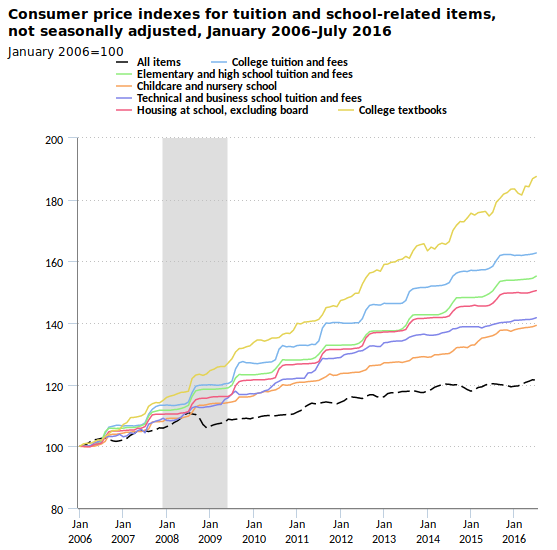Why OER?
There are two potential advantages to using OER in the classroom:
- Textbook Cost
- Freedom!
Textbook Cost
Student costs have increased every year for decades far out striping inflation and consumer price index. From 2006 to 2016 the cost of student housing increased 51% and tuition increased 63%, more than double the rise of the all items consumer price index. However, textbook costs jumped 88%!

This trend has continued, with exploitative pricing models, access codes, and custom editions increasing costs to individual students, while limiting their ability to recoup expenses in the used textbook market. In response, a U.S. PIRG survey shows that almost half of students take fewer courses each semester to avoid textbook costs and 65% of students do not buy required high priced textbooks, which negatively impacted their academic performance.1
Since 2006, the cost of textbooks has increased four times the rate of inflation
At University of Idaho, textbooks are estimated to cost students $1,236 per year.2 The issue of high textbook costs is on student’s minds, try reading comments on the Associated Students of the University of Idaho petition to reduce the cost of textbooks. As instructors it is easy forget that an extra hundred dollars can make a major difference for financially precarious students, and studies show that lowing the cost impacts retention and positive outcomes in courses. For many lower level courses where high quality OERs are readily available, this is low hanging fruit ready to make a big impact on education affordability.
By removing a cost barrier, OER provide students with equal access to the learning materials (no excuse to not have it) and permanent resources.
Freedom
When using open licenses such as Creative Commons , the author does NOT give up their copyright . However, they grant everyone specific permissions to use the materials–freedoms! These are summarized by David Wiley in the Open Content Definition as the “5R permissions”:
5R Permissions
- Retain – the right to make, own, and control copies of the content (e.g. download, duplicate, store, and manage)
- Reuse – the right to use the content in a wide range of ways (e.g. in a class, in a study group, on a website, in a video)
- Revise – the right to adapt, adjust, modify, or alter the content itself (e.g. translate the content into another language)
- Remix – the right to combine the original or revised content with other material to create something new (e.g. incorporate the content into a mashup)
- Redistribute – the right to share copies of the original content, your revisions, or your remixes with others (e.g. give a copy of the content to a friend)
Licenses can also contain requirements (e.g. CC-BY-SA, must share with the same license) or restrictions (e.g. CC-BY-NC, no commercial use) that must be followed to granted the permissions. Remember, OER are more open if you choose simple licenses and open, easy to use formats!
Enjoying the freedoms of open content instructors can:
- Improve, update, or modify to ensure the most relevant content.
- Reformat to create new derivatives appropriate for different means of consuming content such as video, audio, or websites.
- Adapt to the specific context, enabling learning materials to be responsive to your course, students needs, and pedagogy.
To reiterate, cost-free is not the same as free (this is encapsulated well in the concept of Free Software). While cost-free solutions such as reserves are great for students and should be supported by library initiatives, they do not provide the freedoms and permissions afforded by truly open content that enable sustainable innovation and community.
-
U.S. PIRG, Survey shows students opting out of buying high-cost textbooks, 2014. ↩
-
University of Idaho, Cost of Attendance ↩